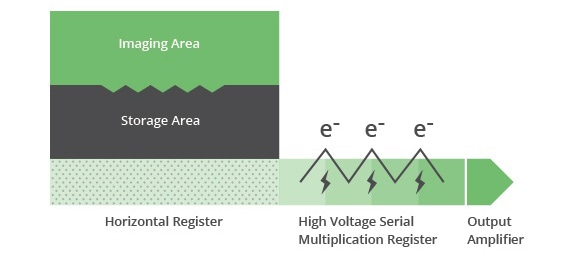Products
Your all-inclusive solution
All Products
Download our catalog
Get our Catalog
Applications
The Electron-Multiplying CCD (EMCCD) is a CCD camera to which is added a special electron multiplication output register. It is designed to practically eliminate the detrimental effect of the readout noise intrinsic to imaging devices, making them significantly more sensitive. The readout noise generates false counts on a level comparable to a signal of a few photons. When the targeted real signal is close to or lower than this noise limit, it cannot be reliably identified by the camera.
By amplifying the incoming signal up to several thousand times, EMCCDs make the readout noise effectively negligible. The EM Gain is the factor associated with this photoelectron amplification. EMCCDs thus can offer ultimate sensitivity for the observation of the darkest scenes by becoming wide-field real-time photon counting imaging devices
EMCCDs use a frame transfer architecture which makes use of 2 regions on the sensor: an imaging area and a storage area. Each region is organized in rows and columns of pixels, which can be seen as points that collect the charges generated by the exposure to light. This matrix of pixels is what will form a recognizable image. While the imaging area is exposed to the signal, the storage area is shielded which enables the readout of a previous exposure simultaneously while acquiring a new image.
At the bottom of the storage area, charges travel pixel by pixel through the multiplication register. There, the charges of each pixel are multiplied up to several thousand times. As a result, an incoming signal of even a few photons can end up as many thousands of photoelectrons. This is what is called the electron multiplication and what makes the readout noise negligible in EMCCDs.
More specifically, the multiplication register is comprised of several hundred electrodes. When a charge in a pixel, an electron, is accelerated by an electrode there is a 1–2% probability that it will generate a secondary electron by a process called impact ionization. This impact ionization achieved by using high voltages, which allow the accelerated photoelectrons to collide with and rip another electron from a silicon atom of the multiplication register. As such, this newly generated electron is added to the signal of the pixel.
While the probability of a single event is low, going sequentially through a large number of electrodes can lead to a multiplication factor of several thousand times; this multiplication factor is the EM Gain (Electron-Multiplication Gain). The level of amplification is controlled by increasing or decreasing the voltage passing through the multiplication register. The colder the sensor, the lower the voltage required to produce impact ionization.
With modern EMCCDs, EM Gain is calibrated over the whole operating range of the camera so that temperature & other factors have no impact on the user-selected EM Gain. As such, when an EM Gain value is chosen, it will always represent the same multiplication factor regardless of the acquisition’s other specific parameters.

Note that the EM registry boosts not only the photoelectron signal but also false counts, which are comprised of dark electrons and clock-induced charges (see this page). Nüvü™ addresses such issues with both the innovative CCD Controller for Counting Photons (CCCP) and unrivaled cooling performances. The first minimizes the clock-induced charge contribution (see Minimizing clock-induced charges) while the latter reduces dark current levels. With these lower noise levels, Nüvü™ is the sole EMCCD camera manufacturer that offers cameras supporting a calibrated EM gain up to 5000.
For most applications, Nüvü™ recommends employing EM gains below 1,000 to avoid dynamic range losses. The camera’s dynamic range is defined as the ratio between the pixel’s full charge capacity (full-well electron capacity) and the camera’s baseline noise level. The multiplication register has a fixed full-well capacity and so higher EM gains mean a lower starting signal will reach this capacity and cause saturation. But lower gains lead to better dynamic ranges, which refine the contrast of the image.
However, for applications requiring photon counting (signals < 1 photon /pixel/image) it is strongly recommended to use EM gain values of more than 3,000 to optimize the sensitivity and dynamic range. Nüvü Camēras is the only EMCCD manufacturer whose sensitivity allows for such high EM gains and therefore efficient photon counting.
Boosting the photoelectron signal comes at a price: the EM registry is a sensitive component that may saturate, and saturation may lead to its premature aging. EM Gain aging manifests as the necessity to use higher voltage in the multiplication register to achieve the same signal amplification.
Fortunately, modern EMCCD cameras include an initial anti-aging process that significantly reduces the impact users can have on the multiplication register. As such, EMCCDs can be used continually for several years without a noticeable effect.